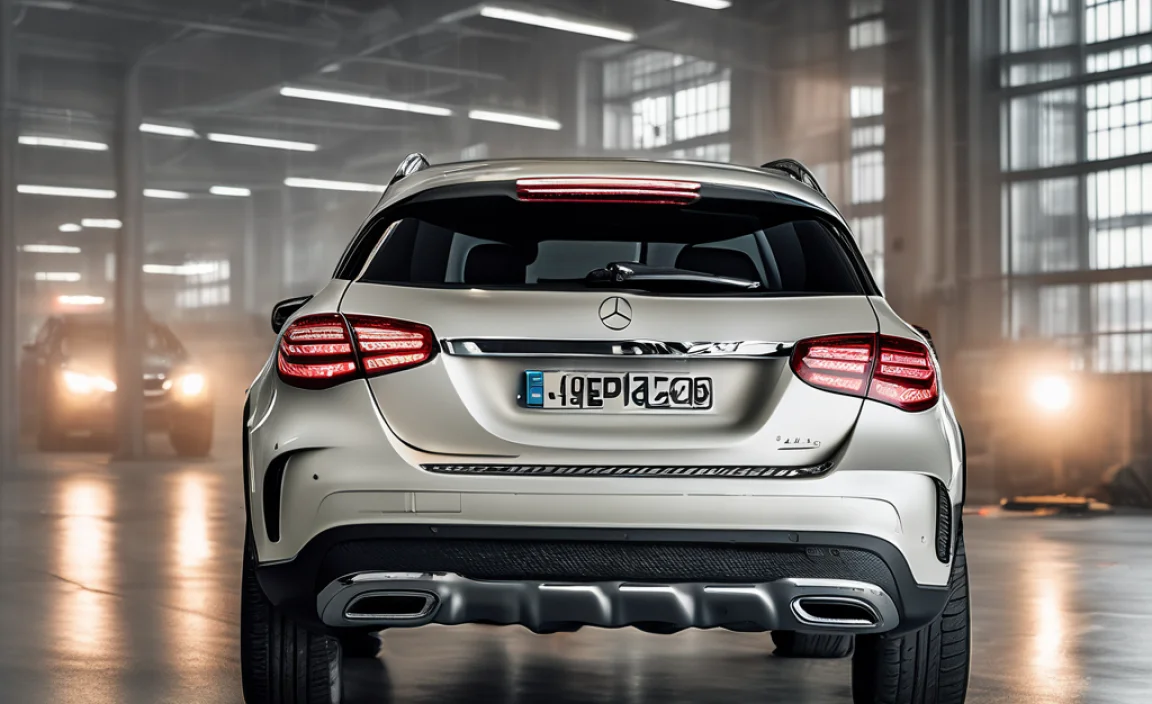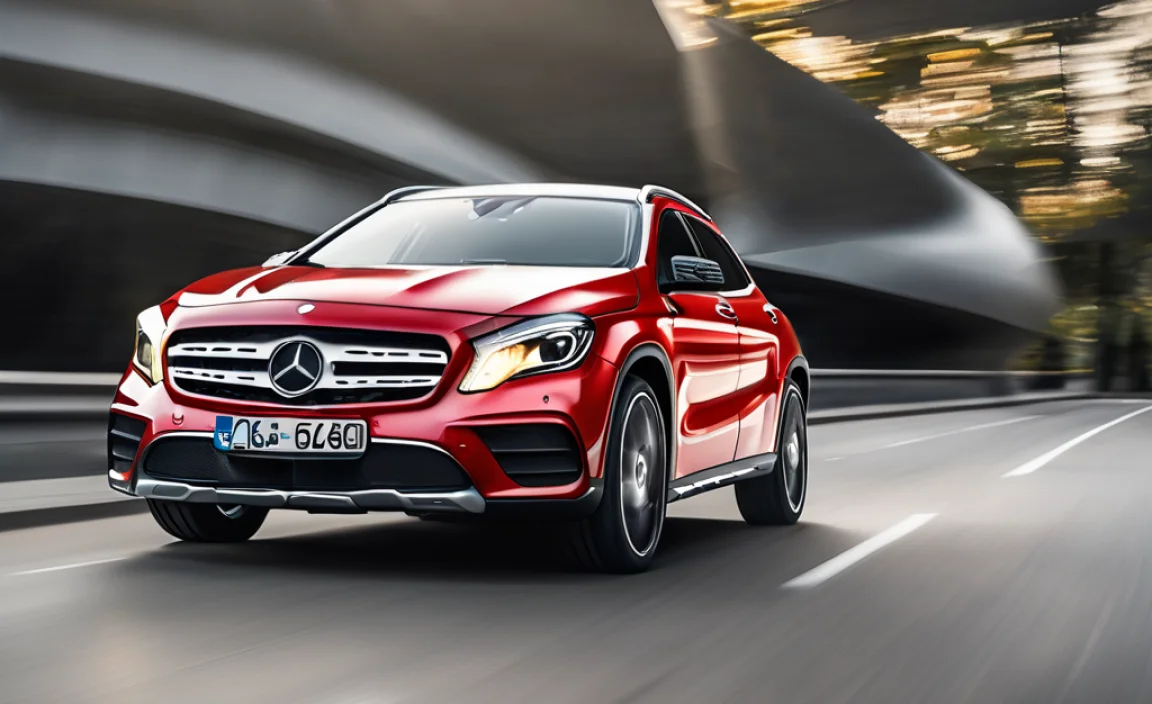The Mercedes-Benz GLA-Class collision warning system is a vital safety feature designed to alert you to potential forward collisions. Understanding how it works and how to maintain it ensures you’re leveraging its full protective capabilities for a safer drive.
Ever had that heart-stopping moment on the road when you suddenly realize you’re a bit too close to the car in front? Most of us have. For your Mercedes-Benz GLA-Class, there’s a smart guardian watching out for you: the Collision Warning system. This fantastic technology is built to help prevent accidents by keeping an extra set of eyes on the road ahead. It can seem a bit mysterious if you’re new to it, but understanding this system is key to making sure it’s always ready to help you stay safe. Don’t worry, it’s simpler than you might think! We’ll break down how this system works, what it does, and how you can be sure it’s functioning perfectly.
Understanding Your Mercedes-Benz GLA-Class Collision Warning System

Your GLA-Class is equipped with an advanced system designed to enhance your driving safety. The Collision Warning system, often part of the COLLISION PREVENTION ASSIST PLUS package or similar driver assistance suites in Mercedes-Benz vehicles, is like a proactive co-pilot. Its primary role is to monitor the distance between your vehicle and the car ahead. When it detects a risk of a collision, it provides you with timely warnings to give you a chance to react and avoid an accident. This system is a cornerstone of modern vehicle safety, aiming to reduce the severity of crashes or prevent them altogether.
At its core, the system uses sophisticated sensors and cameras, typically mounted on the front of the vehicle, to constantly scan the area in front of your GLA. These sensors measure the distance to other vehicles and their speeds. When the system calculates that a collision is imminent based on your current speed and distance, it needs to alert you. This alert is designed to be noticeable without being overly distracting, giving you that crucial window of opportunity to brake or steer away. It’s a testament to Mercedes-Benz’s commitment to pioneering safety technologies for drivers.
How Does Collision Warning Work?
The magic behind your GLA-Class’s collision warning system lies in its integrated sensors and intelligent software. Here’s a simplified breakdown of the process:
- Sensing the Environment: The system uses a combination of radar sensors (often integrated into the front grille or bumper) and sometimes a multi-purpose camera (usually behind the windshield, near the rearview mirror). These components continuously gather data about the vehicles ahead. They measure the distance, relative speed, and even the trajectory of the vehicles.
- Calculating Risk: Sophisticated algorithms process this data in real-time. The system is programmed with specific thresholds. If the calculated time to impact or the closing speed exceeds these thresholds, meaning you’re approaching the vehicle ahead too quickly or are too close for comfort, the system flags it as a potential hazard.
- Issuing Alerts: Once a risk is detected, the system initiates an alert. This usually happens in stages to cater to different levels of urgency.
- Intervention (If Applicable): In many GLA-Class models, especially those with COLLISION PREVENTION ASSIST PLUS, the system doesn’t just warn you; it can also provide partial braking assistance. This means if you don’t react sufficiently to the warning, the car might automatically apply some braking to reduce the impact speed or even help you avoid the collision entirely. This feature underscores the ‘assistance’ aspect of these advanced driver aids.
It’s important to remember that while this system is incredibly advanced, it’s an aid, not a replacement for attentive driving. Your focus and control of the vehicle remain paramount. External factors like heavy rain, fog, or even severe damage to the sensors can sometimes affect its performance, which we’ll discuss later.
Types of Alerts and Warnings

Mercedes-Benz employs a layered approach to alerting drivers, ensuring the warning is appropriate for the situation’s severity. This helps you understand the system’s feedback and respond effectively.
Visual Alerts
The most immediate form of feedback is often visual. When the system detects a potential hazard, you’ll typically see a warning light illuminate on your dashboard. This commonly appears as a red graphic of a car with an arrow pointing towards it, or simply a red warning symbol. This icon acts as a quick, at-a-glance notification that you need to pay attention to your surroundings and your distance from the vehicle in front.
Audible Alerts
Following or sometimes coinciding with the visual warning, you might hear an audible alert. This is usually a distinct chime or beep designed to be urgent enough to get your attention without causing undue panic. The sound is carefully calibrated to cut through ambient noise but isn’t jarring. For instance, if you’re approaching a vehicle too fast, you might hear a series of beeps that get faster as the risk increases.
Active Brake Assist (ABA)
For models equipped with COLLISION PREVENTION ASSIST PLUS, the system can go a step further. If the visual and audible warnings aren’t enough and an impact is still deemed likely, the system may automatically initiate braking. This feature, often referred to as Active Brake Assist (ABA), can significantly mitigate the severity of a collision or even prevent it. It’s crucial to understand that this is an assistance function – it won’t perform miracles if a collision is unavoidable due to extreme speed or circumstances. However, its ability to apply brakes automatically can be a lifesaver in everyday unexpected situations.
The level of intervention can vary. Some systems offer several stages of warnings before any automatic braking occurs, allowing the driver ample opportunity to react. Others might engage braking more readily if the situation is assessed as critical. Always refer to your GLA-Class owner’s manual for specific details about your vehicle’s system and its alert sequence.
When Does the System Activate?

The collision warning system is designed to be a helpful aid, not a constant nuisance. It activates under specific conditions to ensure it’s relevant and effective when you need it most.
- Detecting Vehicles: The system primarily recognizes other vehicles. It’s calibrated to distinguish between stationary vehicles and moving ones. You’ll typically receive a warning if you are approaching a slower-moving vehicle, a stopped vehicle, or a vehicle that has suddenly braked ahead of you.
- Speed Thresholds: The system generally operates within a certain speed range. It’s active at higher speeds to prevent highway incidents and also at lower speeds typical of urban traffic. However, its effectiveness can be reduced at very low speeds or when vehicles are moving extremely slowly.
- Distance Parameters: Each system has pre-set distance parameters it considers safe. If your GLA-Class closes the gap to the vehicle in front too rapidly, exceeding these safety margins, the warning sequence will begin.
- Conditional Operation: The system’s performance can be influenced by external factors. Severe weather conditions like heavy fog, dense snow, or torrential rain can obscure the sensors. Dirt, mud, ice, or snow accumulating on the front sensors or camera can also impair their ability to accurately detect vehicles.
It’s really about the system recognizing a specific, impending danger. It’s not designed to warn you about every car you pass or follow at a safe distance. Think of it as a vigilant guardian that only raises its voice when there’s a genuine reason to be concerned.
Maintaining Your Collision Warning System

Like any advanced technology, your GLA-Class collision warning system requires a little attention to ensure it performs reliably. Regular maintenance is key to keeping this safety feature in top condition.
Keep Sensors Clean
This is perhaps the most critical and simplest maintenance task. The radar sensors and cameras are mounted on the exterior of your vehicle, making them susceptible to dirt, mud, salt, insects, and other debris. If these sensors are blocked, the system won’t be able to accurately “see” the road ahead.
- Weekly Check: Make a habit of visually inspecting the front grille and the area around the windshield where cameras might be located.
- Gentle Cleaning: Use a soft, damp cloth (microfiber is ideal) and mild car soap or a dedicated automotive glass cleaner for the camera lens. Avoid abrasive materials or harsh chemicals that could scratch or damage the sensors.
- Road Salt in Winter: If you live in an area with heavy road salting, pay extra attention to cleaning the front of your vehicle after driving. Salt spray can accumulate quickly and hinder sensor performance.
Regular cleaning ensures that the system has a clear view of the road, functioning as intended by Mercedes-Benz engineers.
Windshield Integrity
If your GLA-Class uses a windshield-mounted camera for its collision warning system (and many do), the condition of your windshield is paramount. A cracked, chipped, or significantly pitted windshield can distort the camera’s view.
- Minor Chips: Even small chips directly in the camera’s field of vision can cause issues. Have them professionally repaired as soon as possible. Repairing chips is often covered by comprehensive auto insurance with no deductible.
- Cracks: Large cracks or a significantly damaged windshield will likely require replacement.
- After Replacements: If your windshield is replaced, ensure the shop calibrates the camera system afterward. This is a crucial step, as the camera needs to be precisely aligned with the vehicle’s systems. You can learn more about ADAS (Advanced Driver-Assistance Systems) calibration from resources like the I-CAR website, which provides industry standards and best practices for collision repair and calibration.
A clear and intact windshield is fundamental for the camera-based systems to work correctly.
Regular Service and Software Updates
Like other complex electronic systems in your GLA-Class, the collision warning system relies on software. Mercedes-Benz regularly releases software updates that can improve system performance, fix bugs, or even add new functionalities.
- Dealership Visits: When you take your GLA-Class in for scheduled maintenance, your dealership will typically check for and install any available software updates for the vehicle’s control units, including those managing driver assistance systems.
- Diagnostic Checks: A technician can also perform diagnostic checks on the collision warning system to ensure all components are functioning within their specified parameters.
While you can’t perform software updates yourself without specialized equipment, ensuring your vehicle receives regular manufacturer-recommended service is the best way to keep its sophisticated electronic systems up-to-date and optimized.
Troubleshooting Common Issues

While the advanced systems in your GLA-Class are generally reliable, you might encounter occasional issues. Understanding common problems can help you address them quickly.
False Warnings
Sometimes, the collision warning system might activate when there isn’t an immediate danger. This can be unnerving but is often due to a misunderstanding by the system.
- Overhead Signs/Bridges: In certain conditions, sensors can sometimes misinterpret large overhead signs, bridges, or even guardrails as obstacles. This is more common at specific angles or speeds.
- Lane Markings: Poorly maintained or unusual lane markings can occasionally confuse camera-based systems.
- Weather: Heavy rain, snow, or fog can lead to temporary false alerts as the sensors struggle to get a clear reading.
- Stationary Objects: While designed to recognize vehicles, sometimes very large, static objects near the edge of the road might trigger a warning, especially in sharp turns.
If you experience frequent false warnings, it’s a good idea to have the system checked by a qualified technician. Cleaning the sensors and ensuring your windshield is clear are the first steps.
System Unavailable or Malfunctioning
You might see a message on your dashboard indicating that the collision warning system is unavailable or malfunctioning. This can happen for several reasons:
- Sensor Blockage: As mentioned, dirt, ice, or damage to sensors is the most common culprit.
- Damaged Sensors/Camera: If the sensors or camera have been physically damaged (e.g., from a minor impact or debris), they will need professional repair or replacement.
- Windshield Issues: Cracks or significant damage to the windshield in the camera’s viewing area will disable camera-based functions.
- System Errors: Electronic glitches can occur. Sometimes, simply turning the vehicle off, waiting a few minutes, and turning it back on can reset the system and clear minor errors.
- Recent Repairs: If you’ve had recent bodywork or windshield replacement, ensure that the collision warning system was recalibrated according to manufacturer specifications by the repair shop. An improperly calibrated system will likely show a malfunction.
For any persistent “system unavailable” messages, a visit to a Mercedes-Benz authorized service center is recommended. They have the diagnostic tools to pinpoint the exact issue. You can find more information on automotive sensor technology and its challenges on resources like SAE International, a leading source for mobility engineering standards and knowledge.
Understanding the Limitations
It’s essential to have realistic expectations about any driver assistance system, including your GLA-Class’s collision warning. While highly advanced, these systems have inherent limitations. Knowing these limitations is crucial for safe driving practices.
- Not Autonomous Driving: Collision warning systems are aids, not a step towards fully autonomous driving. They are designed to assist you, not to drive the car for you. You must remain in control at all times.
- Weather Dependency: Performance can be significantly impacted by adverse weather conditions. Heavy rain, snow, fog, and even direct, harsh sunlight can interfere with sensor readings and camera accuracy.
- Sensor Range and Field of View: While impressive, sensors and cameras have a finite range and field of view. They may not detect obstacles at extreme distances or those that appear suddenly from unexpected directions.
- Complex Scenarios: The system may struggle with very complex traffic situations, such as multiple vehicles cutting in and out of lanes, or unusual road geometries.
- Detection of Non-Vehicular Objects: The primary function is to detect other vehicles. While some systems have pedestrian detection capabilities, they may not reliably detect all other types of obstacles, cyclists, or animals.
- Road Conditions: The system relies on clear road markings and predictable traffic patterns. It may not function optimally on unpaved roads, construction zones, or in areas with poor road infrastructure.
Always remember that the driver is ultimately responsible for the safe operation of the vehicle. These systems are there to provide an extra layer of awareness and assistance, augmenting your own vigilance.
Frequently Asked Questions (FAQ)
Q1: How do I know if my GLA-Class has a collision warning system?
A1: Most newer Mercedes-Benz GLA-Class models come standard with Collision Prevention Assist, which includes the collision warning. You can check your vehicle’s original window sticker or your owner’s manual. Also, look for the warning light symbol on your dashboard; if you can access various warning light displays through your instrument cluster menu, it likely has the system.
Q2: Can I turn off the collision warning system?
A2: Yes, typically you can disable or adjust the sensitivity of the collision warning system. This is usually done through the vehicle’s infotainment system menu (“Settings” -> “Assistance” or similar). However, it is strongly recommended to keep the system active for enhanced safety, especially when driving in traffic.
Q3: What is the difference between Collision Prevention Assist and COLLISION PREVENTION ASSIST PLUS?
A3: Collision Prevention Assist primarily provides audible and visual warnings. COLLISION PREVENTION ASSIST PLUS adds the capability of partial autonomous braking (Active Brake Assist) if the driver doesn’t react sufficiently to the warnings.
Q4: My car is giving me collision warnings when nothing is there. What should I do?
A4: This could be due to a variety of factors, including dirty sensors, a damaged windshield, or environmental conditions. First, ensure all sensors on the front of your car and the area around the windshield camera are clean. Check your windshield for chips or cracks. If the problem persists, it’s best to have it inspected by a qualified Mercedes-Benz technician.
Q5: If my collision warning system malfunctions, will it affect other safety features?
A5: It’s possible. Many of the driver assistance systems in your GLA-Class are interconnected and use shared sensors and cameras. If the collision warning system is malfunctioning due to a sensor issue, other systems that rely on the same sensor (like adaptive cruise control or active lane keeping assist) might also be affected or unavailable.
Q6: How often should I have my collision warning system checked?
A6: Beyond regular cleaning and visual inspection by you, the system should be checked by a technician during your vehicle’s routine scheduled maintenance intervals. Any time you experience persistent issues, or after an accident or significant impact, a professional check and recalibration are essential.
<div style=”